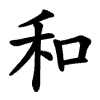和
- harmony;
- peace;
Etymology
Phono-semantic compound:
口 (“mouth, speech”) provides the semantic element, suggesting harmony through words or sound.
禾 (“grain, rice plant”) provides the phonetic element and also hints at agrarian life, balance, and nourishment.
Semantic range:
- to harmonize, make peace (화하다, 화목하다);
- gentle, moderate, calm (온화하다, 부드럽다);
- union, blending, concord (조화, 합치다);
- in mathematics, the “sum” (덧셈 결과).
Usage in Korean
화합 (和合) — harmony, concord
화평 (和平) — peace, reconciliation
중화 (中和) — neutralization, moderation
조화 (調和) — balance, harmony
Words that derived from 和
- 강화하다(講和하다)–make peace
- 공화국(共和國)–republic
- 남아프리카 공화국(南Africa共和國)–South Africa
- 세계평화통일가정연합(世界平和統一家庭聯合)–Family Federation for World Peace and Unification
- 조화(調和)–getting along with; going with
- 중화(中和)–neutralization
- 천주평화연합(天宙平和聯合)–Universal Peace Federation
- 평화(平和)–peace
- 포화(飽和)–saturation
- 화해(和解)–reconciliation; settlement; compromise
Additional notes
In Confucian thought, 和 is central to the idea of social and cosmic harmony. The Doctrine of the Mean (中庸) praises 和 as the highest state of balanced interaction, where differences coexist without conflict.
In Daoism, 和 resonates with the principle of complementarity and natural balance (陰陽和).
In Japanese culture, 和 (wa) evolved into a national self-concept symbolizing social concord, modesty, and integration, influencing aesthetics, cuisine (和食), and national identity (大和).
- 竹木口 (HDR)
- ⿰ 禾 口
